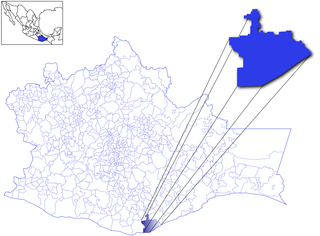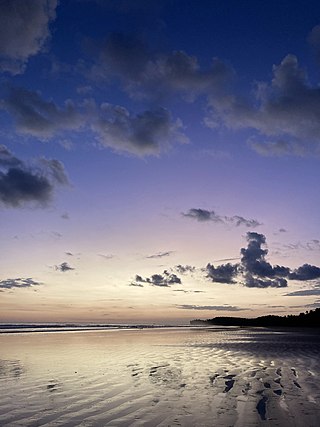
New Urbanism is an urban design movement that promotes environmentally friendly habits by creating walkable neighbourhoods containing a wide range of housing and job types. It arose in the United States in the early 1980s, and has gradually influenced many aspects of real estate development, urban planning, and municipal land-use strategies. New Urbanism attempts to address the ills associated with urban sprawl and post-WW II suburban development.

Guanacaste is a province of Costa Rica located in the northwestern region of the country, along the coast of the Pacific Ocean. It is bordered by Nicaragua to the north, Alajuela Province to the east, and Puntarenas Province to the southeast. It is the most sparsely populated of all the provinces of Costa Rica. The province covers an area of 10,141 square kilometres (3,915 sq mi) and as of 2010, had a population of 354,154, with annual revenue of $2 billion.

Bocas del Toro (Spanish pronunciation:[ˈbokasðelˈtoɾo]; meaning "Mouths of the Bull") is a province of Panama. Its area is 4,643.9 square kilometers, comprising the mainland and nine main islands. The province consists of the Bocas del Toro Archipelago, Bahía Almirante, Chiriquí Lagoon, and adjacent mainland. The capital is the city of Bocas del Toro on Isla Colón. Other major cities or towns include Almirante and Changuinola. The province has a population of 159,228 as of 2023.

Liberia is a district and the largest city in the Guanacaste Province of Costa Rica, located 215 kilometres (134 mi) northwest of the national capital, San José. Part of the Liberia canton, it is a major center for the country's tourism industry.

Rosemary Beach is an unincorporated planned community in Walton County, Florida, United States on a beach side road, CR 30A, on the Gulf Coast. Rosemary Beach is developed on land originally part of the older Inlet Beach neighborhood. The town was founded in 1995 by Patrick D. Bienvenue, President of Leucadia Financial Corporation, and was designed by Duany Plater-Zyberk & Company. The town is approximately 105 acres (0.42 km2) and, upon completion, included more than 400 home sites and a mixed-use town center with shops, restaurants, and activities.

Huatulco, formally Bahías de Huatulco, centered on the town of La Crucecita, is a tourist development in Mexico. It is located on the Pacific coast in the state of Oaxaca. Huatulco's tourism industry is centered on its nine bays, thus the name Bahías de Huatulco, but has since been unofficially shortened to simply Huatulco. Huatulco has a wide variety of accommodation from rooms for rent, small economy hotels, luxury villas, vacation condominia, bed and breakfasts, as well as several luxury resorts standing on or near the shores of Tangolunda Bay. The Camino Real Zaashila, Quinta Real Huatulco, Las Brisas, Dreams Resort & Spa, and the Barceló are examples of the most popular larger resorts in the area.
Charles Brewer is an American entrepreneur.

Maspalomas is a tourist resort in the south of the island of Gran Canaria, Canary Islands, stretching from Bahía Feliz in the east to Meloneras in the west, including the resort towns of San Agustín, Playa del Inglés and San Fernando. Maspalomas constitutes the southernmost part of the municipality of San Bartolomé de Tirajana, and of the island.
Iguanita Wildlife Refuge is a wildlife refuge in the Guanacaste Conservation Area located in the Guanacaste Province of northwestern Costa Rica.

Tamarindo is a district of the Santa Cruz canton, in the Guanacaste province of Costa Rica, located on the Nicoya Peninsula.

Playa Grande, also known as Salinas, is a beach community on the Pacific coast of Costa Rica just north of Tamarindo. It is located inside the canton of Santa Cruz in Guanacaste Province. Playa Grande has been part of the Parque Nacional Marino Las Baulas since 1990. There are palm trees and vegetation around the beach, which stretches for about 4.5 kilometers. It is part of the Las Baulas National Marine Park, which was established to protect the nesting grounds of endangered leatherback turtles. Playa Grande is one of the major nesting sites for these turtles, and visitors can witness the nesting and hatching process during the nesting season, which typically occurs from October to March. The main attraction of Playa Grande is its surf breaks. The beach has consistent waves. Playa Grande is an ideal destination for nature lovers, with diverse ecosystems surrounding it. Beyond the beach, you can explore the nearby mangrove forests, take boat tours along the estuaries, or venture into the neighboring national parks, such as Rincon de la Vieja or Santa Rosa, which offer hiking trails, wildlife spotting opportunities, and breathtaking landscapes.
Tamarindo River is a river in the Guanacaste Province of Costa Rica. The estuary is adjacent to the town of Tamarindo. The river spans 490 hectares and serves as the natural border between Tamarindo and Playa Grande. The estuary is home to much wildlife, including ospreys, herons and kingfishers in addition to howler monkeys and coatimundis. In particular, it hosts the American crocodile, which draws tourists to the estuary. The river estuary is a popular place for surfing despite the local caiman population.

Nosara is a district of the Nicoya canton, in the Guanacaste province of Costa Rica.

Carrillo is a canton in the Guanacaste province of Costa Rica. The head city is in Filadelfia district.

Tourism in Costa Rica has been one of the fastest growing economic sectors of the country and by 1995 became the largest foreign exchange earner. Since 1999, tourism has earned more foreign exchange than bananas, pineapples and coffee exports combined. The tourism boom began in 1987, with the number of visitors up from 329,000 in 1988, through 1.03 million in 1999, over 2 million in 2008, to a historical record of 2.66 million foreign visitors in 2015. In 2012, tourism contributed with 12.5% of the country's GDP and it was responsible for 11.7% of direct and indirect employment. In 2009, tourism attracted 17% of foreign direct investment inflows, and 13% in average between 2000 and 2009. In 2010, the tourism industry was responsible for 21.2% of foreign exchange generated by all exports. According to a 2007 report by ECLAC, tourism contributed to a reduction in poverty of 3% in the country.

La Fortuna is a district of the San Carlos canton, in the Alajuela province of Costa Rica.

Papagayo Peninsula is located on the north Pacific coast of Costa Rica in the northwest province of Guanacaste. It is located in the Golfo de Papagayo and was formed by volcanic activity as the Caribbean tectonic plate continuously overrode the Cocos Plate and by subsequent weather erosion. The 15 miles (24 km) at the coastline contains 31 separate beaches. The larger Elena Peninsula Santa to the north protects the waters in the Papagayo Peninsula.

Puerto Carrillo is a district of the Hojancha canton, in the Guanacaste province of Costa Rica.
Playa Flamingo is one of Costa Rica's most popular beaches with fine white sand. It has pristine clear blue waters, lagoons, vegetation and abundance of activities. The Playa Flamingo area offers a wide variety of secluded beaches and lagoons due to the mountain formations reaching into the sea. It features hotels, lodging, luxury homes, entertainment, water, land and leisure activities.

Uvita de Osa is a small town in southern Costa Rica, on a section of coastline known as the Bahía Ballena. It is notable for hosting the annual music event and being home to the Cola de Ballena beach which is one of the beaches comprising Marino Ballena National Park. The Whale's Tail has been described as one of the world's most beautiful beaches. Uvita is a good place to see humpback whales in the wild, as there are groups which come from Northern California and Alaska during one time of the year and groups that come from the south and Antarctica during another time of the year. Uvita has grown tremendously since the early 2000s and is the commercial center of the Costa Ballena region. Many expatriates from North America and Europe have made Uvita their home, so many of the locals speak English as well as Spanish.
















